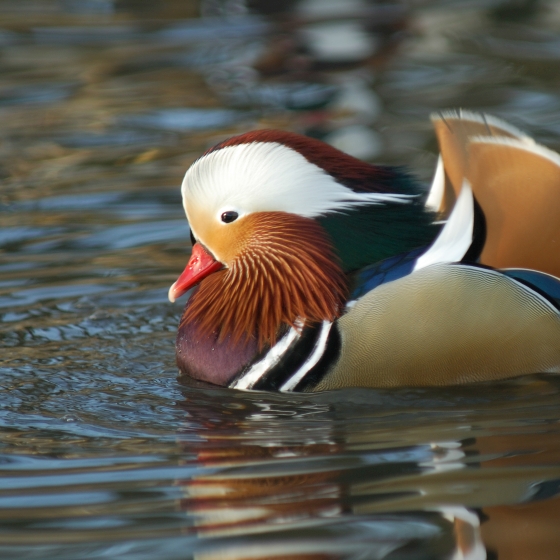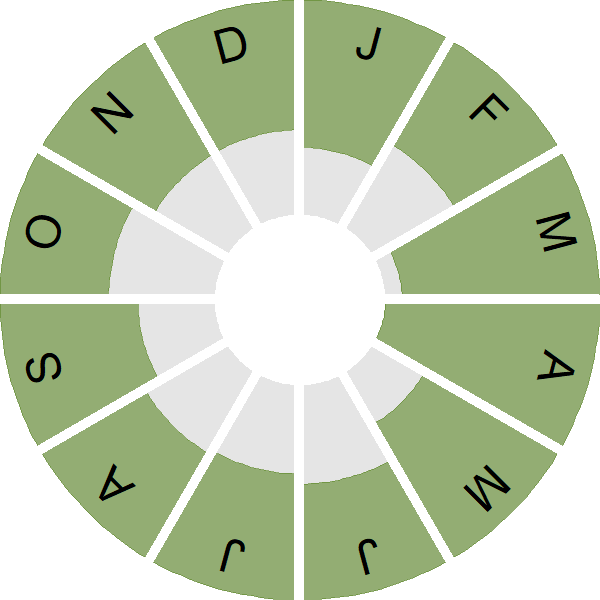Mandarin Duck

Introduction
The drake Mandarin Duck is gaudy and one of our most resplendent ducks. The female is contrastingly conservative, a smart grey and brown.
A timid duck of river valleys and small waterbodies with well-vegetated margins. These small ducks nest in tree cavities and will use nest boxes. Up to 12 ducklings jump from the nest before they can fly and follow the female to the nearest water.
Native of Asia, the Mandarin Duck became naturalized in the UK in the 20th century and is now found across England and parts of Scotland and Wales, with the Wetland Bird Survey reporting an upward UK trend. Outside of the breeding season, Mandarin Ducks gather in flocks relatively close to their breeding sites, although bird ringing has revealed a few long-distance movements.
- Our Trends Explorer gives you the latest insight into how this species' population is changing.

Key Stats
Identification
ID Videos
This section features BTO training videos headlining this species, or featuring it as a potential confusion species.
Mandarin & Wood Duck
Songs and Calls
Call:
Flight call:
Status and Trends
Conservation Status
Population Change
The causes of change are uncertain. However, the increases following introduction may have been aided by lack of intraspecific competition and the ability of this species to exploit a previously unoccupied habitat; there is no evidence yet that density-dependent effects have slowed the rate of increase.
Distribution
Away from the swathe of records in southern and central England, the breeding distribution map shows tight clustering in areas of suitable breeding habitat such as Jersey, south Devon, Kielder Forest in Northumberland, Argyll Forest Park and around Inverness and Berwick. They are scarce in Wales.
Occupied 10-km squares in UK
or view it on Bird Atlas Mapstore.
or view it on Bird Atlas Mapstore.
European Distribution Map
Distribution Change
There has been considerable range expansion since the 1988–91 Breeding Atlas, particularly through southern and central England, with an overall 123% increase in range size.
Change in occupied 10-km squares in the UK
or view it on Bird Atlas Mapstore.
or view it on Bird Atlas Mapstore.
Seasonality
Mandarin Ducks are localised residents and can be seen throughout the year.
Weekly pattern of occurrence
The graph shows when the species is present in the UK, with taller bars indicating a higher likelihood of encountering the species in appropriate regions and habitats.

Movement
Britain & Ireland movement
Foreign locations of birds ringed or recovered in Britain & Ireland
Dots show the foreign destinations of birds ringed in Britain & Ireland, and the origins of birds ringed overseas that were subsequently recaptured, resighted or found dead in Britain & Ireland. Dot colours indicate the time of year that the species was present at the location.
- Winter (Nov-Feb)
- Spring (Mar-Apr)
- Summer (May-Jul)
- Autumn (Aug-Oct)

European movements
EuroBirdPortal uses birdwatcher's records, such as those logged in BirdTrack to map the flows of birds as they arrive and depart Europe. See maps for this species here.
The Eurasian-African Migration Atlas shows movements of individual birds ringed or recovered in Europe. See maps for this species here.
Biology
Productivity and Nesting
Nesting timing
Egg measurements
Clutch Size
Survival and Longevity
Survival is shown as the proportion of birds surviving from one year to the next and is derived from bird ringing data. It can also be used to estimate how long birds typically live.
View number ringed each year in the Online Ringing Report.
lifespan
Biometrics
Wing length and body weights are from live birds (source).
Wing length
Body weight
Ring Size
Classification, names and codes
Classification and Codes
- Order: Anseriformes
- Family: Anatidae
- Scientific name: Aix galericulata
- Authority: Linnaeus, 1758
- BTO 2-letter code: MN
- BTO 5-letter code: MANDA
- Euring code number: 1780
Alternate species names
- Catalan: ànec mandarí
- Czech: kachnicka mandarínská
- Danish: Mandarin-and
- Dutch: Mandarijneend
- Estonian: mandariinpart
- Finnish: mandariinisorsa
- French: Canard mandarin
- German: Mandarinente
- Hungarian: mandarinréce
- Icelandic: Mandarínönd
- Irish: Lacha Mhandrach
- Italian: Anatra mandarina
- Latvian: mandarinpile
- Lithuanian: mandarinine antis
- Norwegian: Mandarinand
- Polish: mandarynka
- Portuguese: pato-mandarim
- Slovak: kacicka mandarínska
- Slovenian: mandarinka
- Spanish: Pato mandarín
- Swedish: mandarinand
- Welsh: Hwyaden Mandarin
Research
Causes of Change and Solutions
Causes of change
No further information is available.
Further information on causes of change
No further information is available.
Information about conservation actions
As a non-native introduced breeding species, this species does not have a conservation status in the UK. The native population in Asia is currently classified as being of least concern.
It is believed that the Mandarin Duck is unlikely to have any significant ecological impact on native species, and a risk assessment in the Netherlands classified the species as a low risk (van Kleunen & Lemaire 2015). Although this may also be the case across most of England, there are concerns that the species may impact on other hole-nesting ducks (e.g. Goldeneye and Goosander), particularly in the core Goldeneye breeding area in northern Scotland (Cosgrove 2003), and hence policy makers may need to consider whether any conservation action may be required in order to protect these native breeding species.

